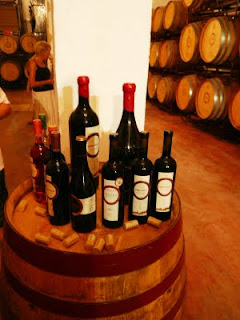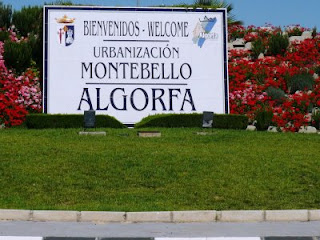When we get rain here, which is not often, it almost always comes very conveniently at night. This time it started on Sunday mid-morning, and continued on and off all that day and night. Monday morning during a temporary "off" period we went out to the grocery store, since the rain the day before had kept us away from the local Sunday market. We bumped into friends at Lidl, decided to go for a cup of coffee, and sat too long inside talking as the rain poured down.
When we left we drove through rain-filled streets with water up to our hubcaps. We made our way slowly towards home, which thankfully sits on higher ground than the surrounding area, but we still had to get through that lower surrounding area. At the roundabout leading from the highway toward Montebello, we encountered more water, a couple cars coming toward us very slowly, and another abandoned on the side of the road. As we rounded a curve, we saw a car up ahead stalled in water up to the windows. We turned around and headed back to Ciudad Quesada, the closest commercial area, to find a more comfortable place to wait until the water went down.
El Bancal restauante was the first dry spot we came to--though the downstairs ladies room was flooded so the mens on the upper level became unisex. We warmed up in the restaurante with a tasty goulash soup and glass of wine. After ninety minutes or so we ventured out again, but only because a man there spoke on his cell phone with a friend in Montebello, who told him that the roundabout at the highway was now cordoned off but we might be able to get in by driving north to the town of Algorfa and then back south to come in "the back way." We did, holding our breath for much of the half hour it took to follow this detour, and arrived at our Montebello entrance intact and with motor still running.
Our house and most of the develoment were weathering the torrent with no problems, though the following day we discovered that a wall surrounding the green rubbish dumping area--adjacent to the back road by which we came--had caved in with the force of the rushing water.
Subsequent newspaper reports said that the torrents brought 100 liters of water per square meter in just four hours. If you don't know exactly how much that is, you are not alone. It is a lot! Hundreds of drivers abandoned their cars, and dozens of people had to be evacuated from their homes. But amazingly after the rains stopped, the water receded rapidly. By the next morning, when we had a 9:00 appointment to have the car inspected prior to its official inpection, we were able to drive out the front road, but the appointment was postponed as garages had more business than they could handle rescuing and cleaning mud-packed vehicles.
The news reports that this was the worst gota fría in twelve years. Also that it was only the first one of the season.











